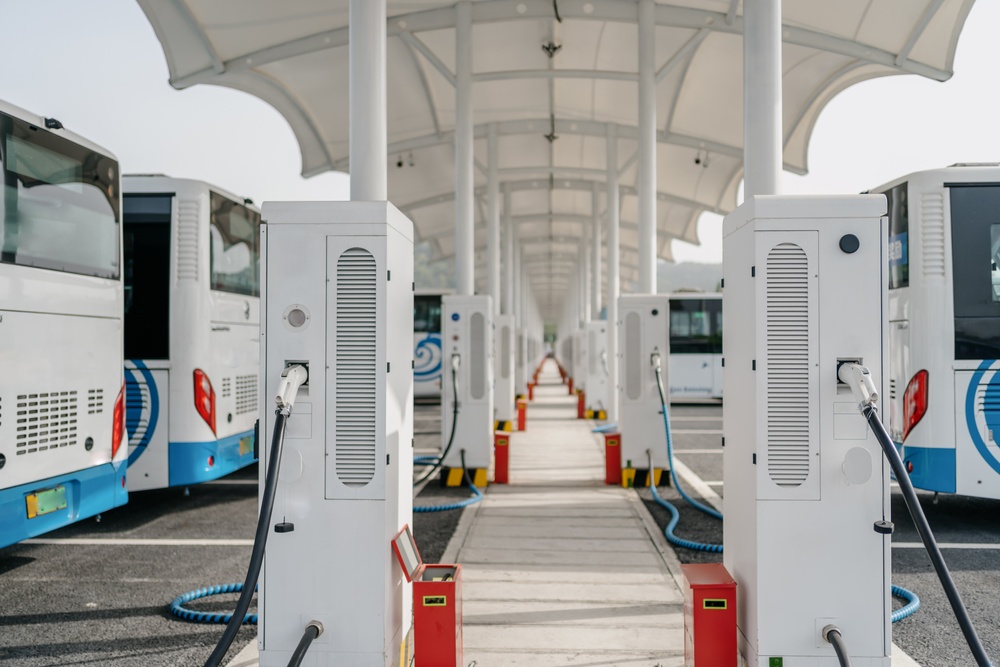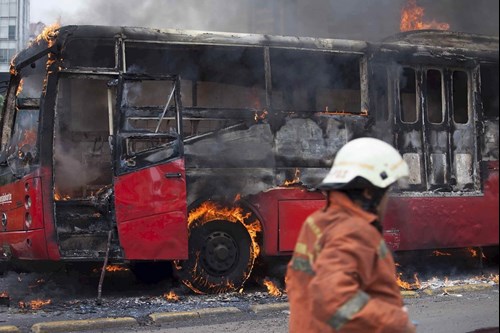Electric and hybrid buses - New fire risks and how to stop them

As we drive to meet global climate change targets, demand for renewable and sustainable fuel sources is increasing. For the automotive industry, this is seeing increased demand for electric and hybrid public transport – namely, buses and coaches.
In this blog, we unpick the impact of electrification on the bus industry’s current and evolving fire risks, exploring how vehicle owners and operators can act to reduce these risks safely.
Changes in European regulations
The United Nations Economic Commission for Europe (UNECE) enacted Regulation 107 to strengthen the safety of buses and coaches, by making it mandatory for commercial combustion engine buses to have a suitable fire suppression system installed. However, this doesn’t address the new fire risks brought about by electric vehicles (EVs) or hybrid vehicles (HEVs). Often powered by lithium-ion (li-ion) batteries, these vehicles have substantially different risks from traditional combustion engine buses and coaches.
Under existing regulations, it’s not currently compulsory for vehicles without combustion engines (including EVs) to feature automated fire suppression systems. As a result, in the event of a fire, an external system and a manual extinguishing function will need to work together to eliminate fire risk, increasing the chance of fire spread and extending any period of operational downtime.
Acknowledging the potential risks for EVs and HEVs, where there is a risk of thermal runaway, UNECE Regulation 100 (Construction and Safety of Electric Powertrains) advises an early warning system is most effective to ensure safety. To detect potential battery failure in the earliest possible stage, fire suppression systems can also add a layer of safety to EVs and HEVs, releasing cooling agents when temperature increases are detected to minimise risk.
New fire risks presented by electric buses
Thermal runaway is the most prevalent risk associated with Li-ion batteries. This state occurs when a battery’s cells malfunction – as a result of physical damage, overheating, overcharging or overvoltage – causing rapid temperature increases, which in turn can result in fire, toxic emissions and potentially large explosions. When thermal runaway is in train, an automatic system shutdown will not prevent its progress.
When thermal runaway is at play, electric fires can take days – or even weeks – to full extinguish, and often require excessive quantities of water. An early fire warning system – supported with spot cooling – can help to detect thermal runaway in its earliest stage, localising and suppressing fire risk.
EVs and HEVs in public transport bring about new fire risks, which need to be acknowledged and addressed to ensure safety. The location of potential risks is also different for EVs and HEVs, as they can be located throughout the vehicle – not just in the engine compartment – so further protection zones are often required to maximise safety and minimise risk.

The Research Institutes of Sweden (RISE) presents a fire risk management assessment, which owners and operators can use to guide risk mitigation for electric buses and coaches. This includes:
- Hazard identification
- Risk estimation
- Risk evaluation
- Risk reduction
Hazards can be identified and prioritised using failure mode and effective analysis (FMEA), and these can then be listed in a risk map to offer a holistic view, separating ‘acceptable’ risks from those that need to be addressed.
Risks that need to be addressed can then be put into an action plan, highlighting the necessary risk reduction measures. This may include:
- Risk minimisation or elimination by design
- Active and passive fire protection systems
- Improved maintenance and cleaning procedures
- Improved training and quality procedures
This is critical to maintaining high levels of safety across the bus and coach industry as it evolves.
For more information, or support protecting your electric bus or coach fleet, get in touch.
About Dafo Vehicle
Dafo was founded in 1919 and has developed into a modern, high-tech company committed to offer the very best solutions to its customers. Dafo was one of the first companies in the world which started to develop integrated firefighting solutions for vehicles back in 1976. Dafo Vehicle Fire Protection has three main business areas: Integration (Fire suppression systems integration into OEM production line, Retrofit (Fire suppression systems installed at final customer) as well as Service & Maintenance. The Dafo Vehicle group today consist of several subsidiaries and Dafo dealers – Dafo Vehicle Oy (Finland), Dafo US, Dafo Deutschland, Dafo Russia, Dafo Asia, Dafo Spain, Dafo UK & Ireland, Dafo Middle East, Dafo Chile, Dafo Brasil, Dafo Australia and Dafo Peru. The head office is located in Tyresö, Sweden.
Contacts

Åsa Westhammar
- asa.westhammar@dafo-vehicle.com
- +46 10 1768 186